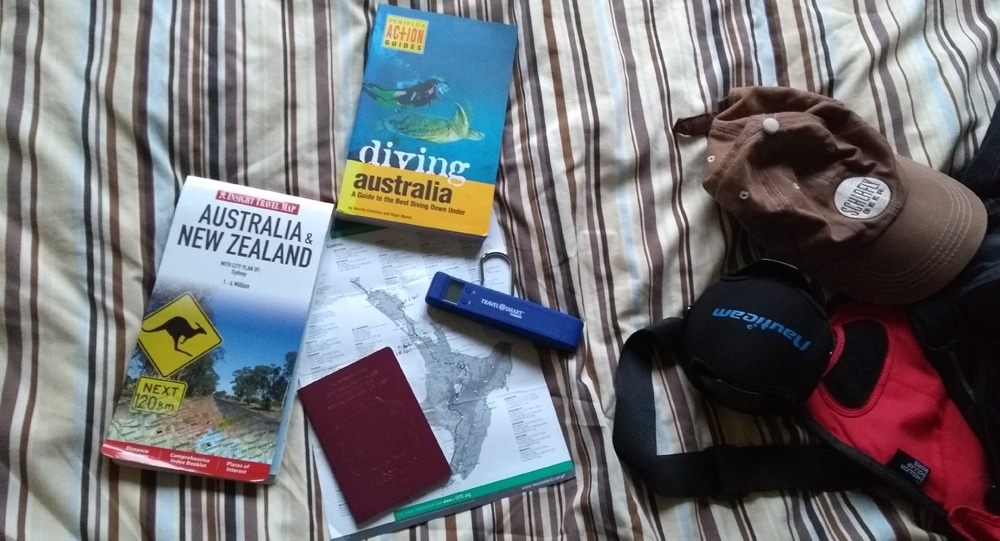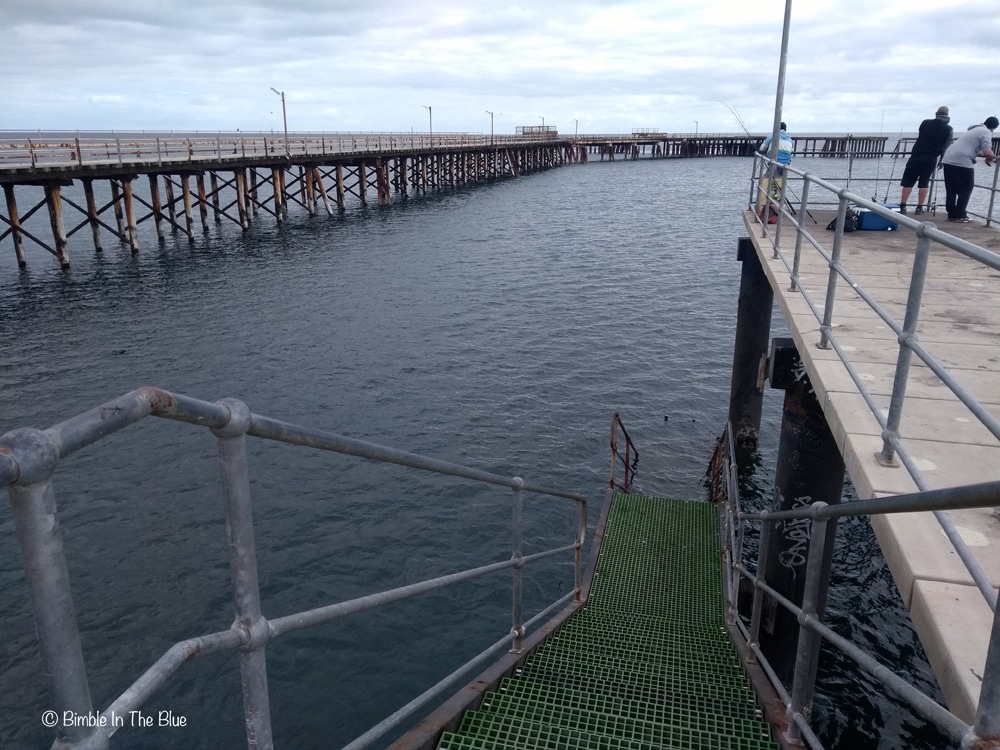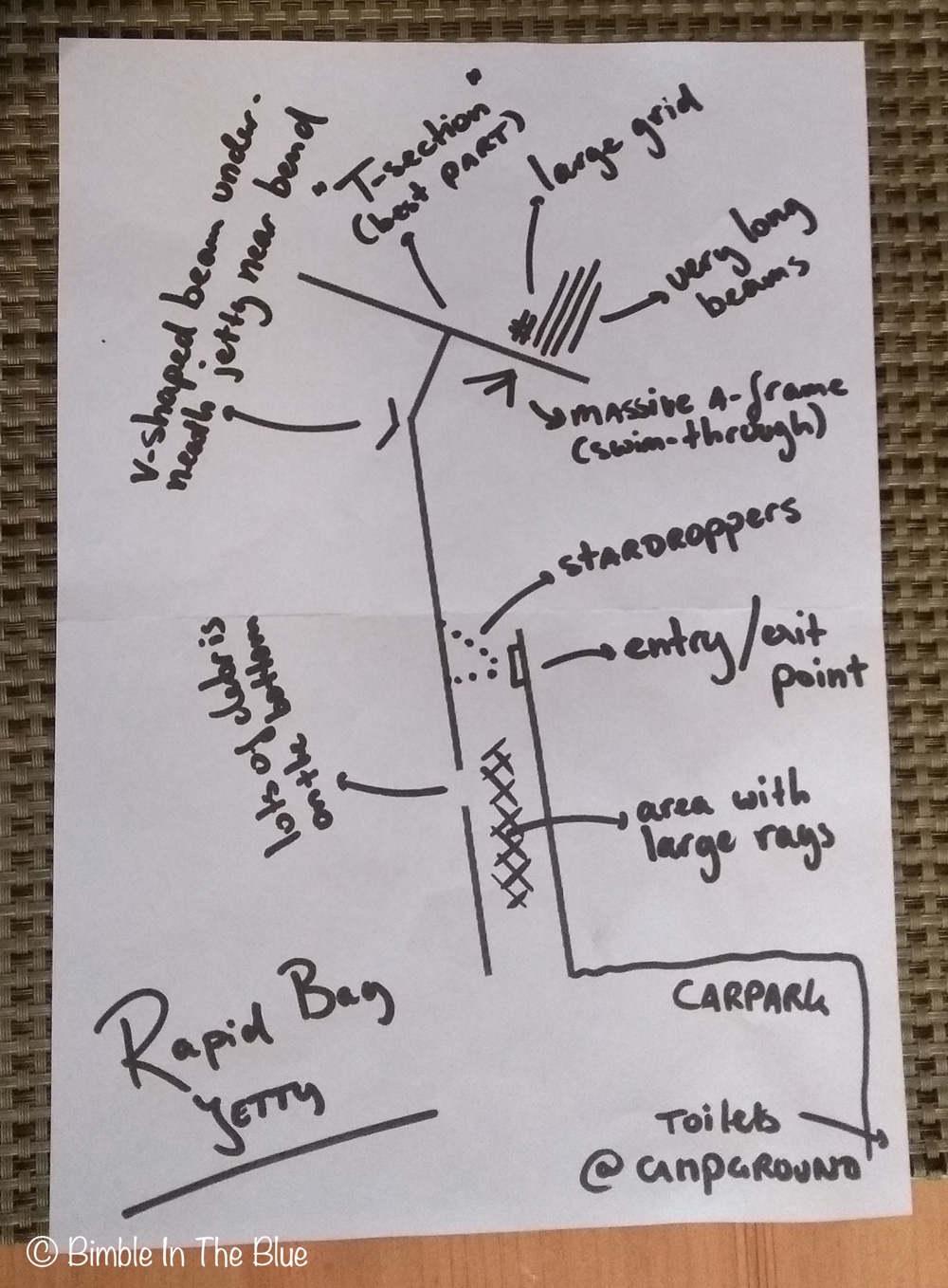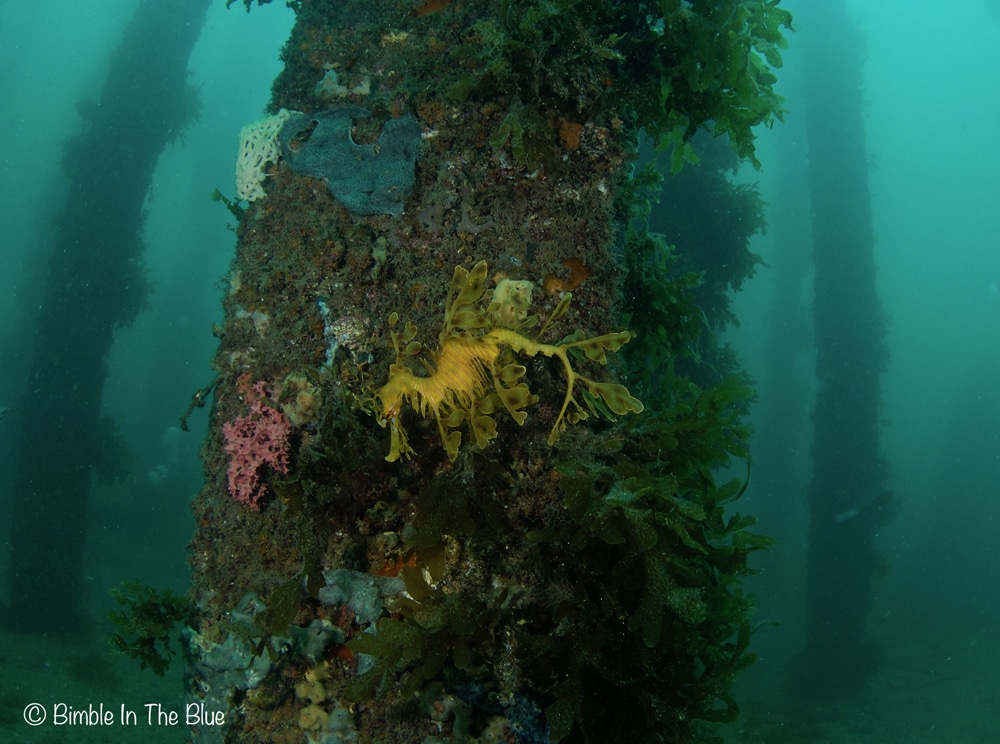News
Shore diving in South Australia: Part 2 – Rapid Bay Jetty

CJ and Mike continue their South Australia shore diving adventures…
Rapid Bay Jetty
The next day the weather forecast was looking a bit better and it was time to check out Rapid Bay Jetty to see if we could find some leafy seadragons! Rapid Bay is an excellent spot for anyone wishing to see leafy seadragons, they seem to thrive here and the dive is shallow and access easy.
We enjoyed the drive and got to see a kangaroo bounding across the road in front of us, having just passed the sign warning us of such. We managed to get a parking space not too far from the jetty and kitted up. The walk was not for the fainthearted, but the return dive route to the ‘Tee’ and right was fantastic. The conditions were good and aside from numerous fish and nudibranchs we got to see two leafy seadragons! We enjoyed it so much we went in for a second dive, to revisit the second leafy and get some more photos.
Rapid Bay Jetty dive details:
- Dive level: Easy.
- Depth: 12m
- Type: Shore dive – Jetty, Photography, Night.
- Vis: 10m
- Marine Life: Invertebrates, schools of fish, rays, leafy seadragons.
- Entry: Steps
- Water temp: 18-21 degrees C (65-70F)
- Facilities: Car park, toilets at nearby campground.
Rapid Bay Jetty is about 1hr 20mins from Adelaide on the Fleurieu Peninsula and has a 450m pier, extending 360m north from shore, then angling to the right for a further 80m and ending in a 200m wharf that used to support ships coming to load up with crushed limestone from the quarry.
The old pier is now in a state of disrepair and is closed to public access, but a new jetty has been built for pedestrians, fishermen and access for divers, 50m away from the original, running parallel for 240m. The new pier has a dedicated entry point for divers at the end, with stairs down to an entry platform and ladder. The stairs have been designed with divers in mind, with nice shallow steps, so its easy to climb them after a dive.
The Jetty is very popular, being a relatively shallow shore dive, protected from prevailing weather for most directions and host to a large variety of fish including the iconic leafy seadragon. The site is very highly regarded for underwater photography and night dives.
Maximum depth at the end of the old jetty is 12 m at high tide while an average depth at the end of the old jetty of 8m. The maximum depth at end of the new jetty is about 5-6m and you can surface swim or descend and swim west across to the old pier, which is better for diving and spotting Leafy Seadragons,.
Vehicles can be parked by the new jetty, but the parking area is long and narrow, so you may have a longer walk if the car park is busy. Public toilets are located in the District Council of Yankalilla campground about 650m to the east. This is a rural area, so it’s best to get food and drink in one of the towns on the way. There is no air filling station, so come with enough tanks for the days diving and a spares kit is useful. The car park is dusty so a ground sheet is useful for setting up equipment in the car park in order to keep equipment clean.
The walk to the entry point is about 240m so some divers like to use a handcart to transport their gear to beside the entry point to kit up. Keep an eye on your air if you want to dive the ‘Tee’ where big schools of fish are known to gather, as the swimming distance is quite long. The old pier is covered in life and so dives can be on any section, depending on your air consumption and fitness. If driving south after your dive, do be aware that the road exceeds 300m in altitude and must be taken into account when considering increased DCI risk after diving.
Next up… Noarlunga Reef.
News
Humpback Mother and Calf Win Underwater Photographer of the Year 2025

Spanish photographer Alvaro Herrero is named Underwater Photographer of the Year 2025, his photograph ‘Radiant Bond’ shows the special relationship between a mother humpback whale and her new-born calf. The photo was taken in French Polynesia and triumphed over 6750 underwater pictures entered by underwater photographers from around the world.
“The mother is accompanying her calf to the surface, because the baby is still so small and clumsy,” explained Herrero. “The calf is releasing a few bubbles underwater showing it is still learning to hold its breath properly. For me, this photo really shows a mother’s love and communicates the beauty and fragility of life in our ocean.”

“This delicate yet powerful study of a mother and calf’s bond says all that is great and good about our world,” commented contest judge Peter Rowlands. “We face our challenges, but the increasing populations of humpback whales worldwide shows what can be achieved.”

Photo: Shunsuke Nakano
Other winners in the International categories included Shunsuke Nakano from Japan with his photo “Face Off”, which shows two extraordinary looking male Asian sheepshead wrasse jousting over spawning rights. “The harem king, on the right, is over 30 years old,” said Nakano, who won the Behaviour category. Abdulaziz Al Saleh, from Kuwait, won the Portrait category with his unique shot “Hydration” showing camels drinking in the desert from below the water. And Bryant Turffs, from the United States, won the Compact cameras category with “The Beauty of the Swamp” with a picture of a prehistoric gar fish taken in the Everglades with a simple GoPro camera.

Photo: Abdulaziz Al Saleh
Ruruka from the Republic of Korea was named as ‘PADI’ Up & Coming Underwater Photographer of the Year 2025 for his photo “Underwater Aurora”, showing of a diver in the multi-coloured waters of a cenote sinkhole, in Mexico. Ruruka purposely visited this cenote during the rainy season, that seas more tannin rich water draining into the sinkhole, creating the bands of coloured water. “From where I live, it’s a very long way to this location, about 24 hours by plane,” said Ruruka. “But it is worth the journey because this unique environment perfectly aligns with the type of images I am trying to create.”

Photo: Ruruka
“An extraordinary image,” commented contest judge Tobias Friedrich. “It is an amazing scene, with a rainbow of freshwater colours in one picture and the high technical quality combined with the golden ratio composition made it a very deserving category winner.”
The Underwater Photographer of the Year contest is based in the UK, and David Alpert, was named as British Underwater Photographer of the Year 2025 for his image “The Curious Seal”, which challenges misconceptions that British waters are murky and lifeless. “My photo is from Lundy Island, a marine protected area since 1973,” explained Alpert. “British seals are delightfully curious, more interactive than any other species I have dived with around the world. Briefly, I become one of the privileged few, crossing the bridge, able to make a connection with a wild animal.”

Photo: David Alpert
“This image is truly a stunner,” comment contest judge Friedrich. “It is well framed in the sea weeds and has beautiful light beams so evocative of shallow waters. The composition is completed by the inquisitive look. An excellent portrait.”
In the same contest, German photographer, Robert Marc Lehmann, was named ‘Save Our Seas Foundation’ Marine Conservation Photographer of the Year 2025, with his photo ‘1 in 200,000,000’, taken in Indonesia. Lehmann’s photo show fishermen hauling a large tiger shark ashore. “This is just one of around 200 million sharks that lose their lives every year at the hands of humans,” said Lehman.

Photo: Robert Marc Lehmann
“The composition is immersive and the timing, capturing the fisherman’s gesture, is decisive,” said contest judge Alex Mustard. “Although an everyday occurrence and legal almost everywhere, the man reaching out to stop the photo reveals what his conscience reckons on what they are doing. A picture that takes you straight into the story.”
About Underwater Photographer of the Year
Underwater Photographer of the Year is an annual competition, based in the UK, that celebrates photography beneath the surface of the ocean, lakes, rivers and even swimming pools, and attracts entries from all around the world. In 2025 the contest attracted 6750 underwater pictures, with the awarded photographers coming from 28 different countries. The contest has 13 categories, testing photographers with themes such as Macro, Wide Angle, Behaviour and Wreck photography, and includes three categories for photos taken specifically in British waters. The winners were announced in an award ceremony in central London, hosted by The Crown Estate. This year’s judges were experienced underwater photographers Peter Rowlands, Tobias Friedrich and Dr Alexander Mustard MBE. The contest was first run in 1965, when Phil Smith was named Underwater Photographer of the Year.
www.underwaterphotographeroftheyear.com
About The Crown Estate
In managing the seabed around England, Wales and Northern Ireland, The Crown Estate works in partnership with customers and stakeholders to support the long-term sustainable development of the seabed. From awarding seabed rights to sharing their knowledge and data, their small expert team directly manage their relationships with customers and partners with a commitment to delivering high levels of customer service.
The Crown Estate sponsor the British Waters Living Together category, host the UPY award ceremony and support an annual print display at the Go Diving show in the UK.
About PADI
PADI® is the largest purpose-driven diving organization with a global network of 6,600 dive centres and resorts, 128,000 professional members and more than 30 million certified divers to date. For over 50 years, PADI has undeniably been the Way the World Learns to Dive, setting the standard for the highest quality dive training, underwater safety and conservation initiatives while evolving the sport of diving into a passionate lifestyle. PADI sponsor the Up & Coming category, championing new talent in underwater imaging.
About the Save Ours Seas Foundation
The Save Our Seas Foundation has funded over 425 projects in 85 countries around the globe since its inception in 2003. Focusing primarily on sharks and rays, each project strives for deeper understanding and more innovative solutions in marine research, conservation and education. The Save Our Seas Foundation are sponsors of the Marine Conservation category, which is free to enter and provides a valuable platform for these important images.
Marine Life & Conservation
Dr. Sylvia Earle Announced as First PADI Emeritus AmbassaDiver

PADI® has announced the first PADI AmbassaDiver™ for 2025: legendary scuba diver, marine biologist, oceanographer and explorer Dr. Sylvia Earle.
“Dr. Earle embodies everything PADI stands for and we celebrate her continued commitment to inspiring future generations of divers and conservationists,” says Kristin Valette Wirth, Chief Brand and Membership Officer for PADI Worldwide. “For decades, she has continued to break through the glass ceiling and show what is possible when it comes to both seeking adventure and saving the ocean. It’s a privilege to amplify her legacy as a scuba diver and ocean advocate.”
Since 2015, the PADI AmbassaDiver program has aimed to amplify the personal stories of exemplary scuba divers who are part of a global team committed to encouraging their communities to experience, explore, and protect the underwater world.
“I am honored to be asked to serve as the first PADI Emeritus AmbassaDiver,” says Dr. Sylvia Earle. “I look forward to being a champion for PADI and using this honor to inspire respect, love, and care for the ocean while providing effective guidance on safety for those who seek adventure underwater.”
Dr. Earle’s key accomplishments for the ocean include:
- one of the first scientists to use scuba to document marine life firsthand
- the first female chief scientist of the National Oceanographic and Atmospheric Administration (NOAA)
- recording the deepest walk on the ocean floor leading the first all-female team of aquanauts for the Tektite II project in 1970
- founding Deep Ocean Exploration and Research in 1992 to develop human-occupied submersibles and other subsea technologies.
- Leading the 5-year Sustainable Seas Expeditions with National in National Marine Sanctuaries
- Founding Mission Blue in 2009 to establish more MPAs and “Hope Spots”
- being awarded TIME Magazine’s first Hero for the Planet in 1998, the 2009 TED Prize, the United Nations Champion for the Earth in 2014, and the Ken Burns Prize in 2024
- authoring over 200+ publications, lecturing in 80+ countries, leading 100+ marine expeditions and spending nearly 10,000 hours underwater
- Co-Hosts the Dive in With Liz and Sylvia program sponsored by the Ocean Elders
“Dr. Earle’s PADI Emeritus AmbassaDiver distinction is more than a title—it will become a powerful movement that engages the global diving community, honors her legacy, and inspires others to rally behind our shared vision to explore and protect the ocean,” continues Valette Wirth.
Twelve additional PADI AmbassaDivers are anticipated to join Dr. Earle as the program’s 2025 inductees later this month. Learn more about the PADI AmbassaDiver team at padi.com/ambassadiver.
About PADI
PADI® (Professional Association of Diving Instructors®) is the largest purpose-driven diving organization with a global network of 6,600 dive centers and resorts, 128,000 professional members, and more than 30million certified divers to date. Committed to our blue planet, PADI makes the wonder of the underwater world accessible to all, empowering people around the world to experience, explore and take meaningful action, as Ocean TorchbearersTM, to protect the world beneath the surface. For over 50 years, PADI is undeniably The Way the World Learns to Dive®, setting the standard for the highest quality dive training, underwater safety and conservation initiatives while evolving the sport of diving into a passionate lifestyle. For divers by divers, PADI is obsessed with transforming lives and, with its global foundation, PADI AWARETM, creating positive ocean change. Seek Adventure. Save the Ocean.SM
-

 Gear Reviews1 month ago
Gear Reviews1 month agoGear Review: SurfEars 4
-

 Marine Life & Conservation2 months ago
Marine Life & Conservation2 months agoPaul Watson Released as Denmark Blocks Japan’s Extradition Bid
-

 Blogs3 months ago
Blogs3 months agoExperience Malta and Gozo in 2025: A Paradise for Divers and Culture Lovers
-

 Blogs2 months ago
Blogs2 months agoJeff Goodman Launches Underwater Moviemaker Course with NovoScuba
-

 News3 months ago
News3 months agoDive into Adventure: Limited Space Available for January Socorro Liveaboard Trip with Oyster Diving
-

 Blogs3 months ago
Blogs3 months agoThe Benefits of Underwater Photography Workshops
-

 News3 months ago
News3 months agoScubaverse Acquired by Multiversal Media: A New Era of Expansion into Outdoor Travel and Wildlife Markets
-

 News3 weeks ago
News3 weeks agoExclusive Shark Diving Adventure in the Maldives – Last Female Space Available!


















